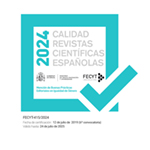Videovigilancia en el centro de Madrid. ¿hacia el panóptico electrónico?
Resumen
En el centro de la ciudad de Madrid existen actualmente 147 cámaras de vigilancia controladas por la Policía Municipal, formando toda una malla de control digitalizado a través del cual la mirada panóptica se impone como un elemento más del espacio urbano, con el fin declarado de producir “espacios seguros”. Lejos de ser un fenómeno en declive, este se presenta cada vez más como una verdadera necesidad por parte del gobierno local de la ciudad, quien a través de su alcaldesa, Ana Botella, ha realizado una petición a la Delegación del Gobierno para la instalación de 46 cámaras de vigilancia más, con el objetivo de crear “un gran entorno comercial y de ocio cubierto con circuito cerrado de televisión” en el marco de un “plan de seguridad ambicioso para el turismo de compras” (ABC, 2014). Uno de los espacios urbanos del centro de Madrid donde más se concentran estos dispositivos es el barrio de Lavapiés, donde hasta un total de 48 cámaras están distribuidas estratégicamente por sus calles. Los discursos desplegados por parte de las autoridades para justificar dicha implementación de lo que se podría denominar un panóptico electrónico aluden a “razones de seguridad” y “la mejora de la calidad de vida de los residentes y visitantes” (Ayuntamiento de Madrid, 2009). Pero ¿de qué calidad de vida y seguridad estamos hablando?, ¿Es la videovigilancia un dispositivo aceptado por los ciudadanos? Tratar de reflexionar sobre estas preguntas y aludir a algunos movimientos de resistencia que han surgido en el barrio de Lavapiés contra este proceso, con el objetivo de cuestionar críticamente algunos presupuestos en materia de seguridad ciudadana, es el objetivo de este artículo. Estas reflexiones, siempre parciales e incompletas, forman parte de una investigación más amplia sobre la seguridad ciudadana en el centro de Madrid llevada a cabo en la actualidad por el autor del artículo.Descargas
##plugins.generic.pfl.publicationFactsTitle##
##plugins.generic.pfl.reviewerProfiles## N/D
##plugins.generic.pfl.authorStatements##
Indexado: {$indexList}
-
##plugins.generic.pfl.indexedList##
- ##plugins.generic.pfl.academicSociety##
- N/D
- Editora:
- Grupo de Investigación Cultura Digital y Movimientos Sociales. Cibersomosaguas
Descarga artículo
Licencia
La revista Teknokultura, para fomentar el intercambio global del conocimiento, facilita el acceso sin restricciones a sus contenidos desde el momento de su publicación en la presente edición electrónica, y por eso es una revista de acceso abierto. Los originales publicados en esta revista son propiedad de la Universidad Complutense de Madrid y es obligatorio citar su procedencia en cualquier reproducción total o parcial. Todos los contenidos se distribuyen bajo una licencia de uso y distribución Creative Commons Reconocimiento 4.0 (CC BY 4.0). Esta circunstancia ha de hacerse constar expresamente de esta forma cuando sea necesario. Puede consultar la versión informativa y el texto legal de la licencia.













